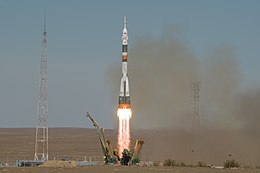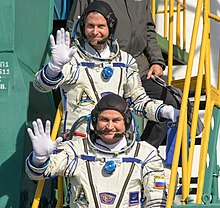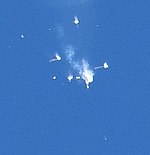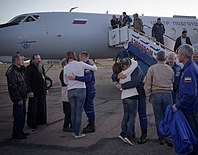
Soyuz is a family of expendable Russian and Soviet carrier rockets developed by OKB-1 and manufactured by Progress Rocket Space Centre in Samara, Russia. With over 1,900 flights since its debut in 1966, the Soyuz is the rocket with the most launches in the history of spaceflight.

Sergey Nikolayevich Ryzhikov, lieutenant colonel of Russian Air Force, is a Russian cosmonaut, selected in 2006. He is a veteran of two long duration space flights to the ISS.

Aleksey Nikolayevich Ovchinin is a Russian Air Force Major and cosmonaut, who was selected in 2006. Ovchinin made his first spaceflight in 2016, and was assigned as Commander of Soyuz MS-10 in 2018.

The Soyuz-FG launch vehicle was an improved version of the Soyuz-U from the R-7 family of rockets, designed and constructed by TsSKB-Progress in Samara, Russia. Guidance, navigation, and control system was developed and manufactured by "Polisvit" Special Design Bureau.

Soyuz TMA-19 was a crewed spaceflight to the International Space Station (ISS) and is part of the Soyuz programme. It was launched on 15 June 2010 carrying three members of the Expedition 24 crew to the International Space Station, who remained aboard the station for around six months. Soyuz TMA-19 was the 106th crewed flight of a Soyuz spacecraft, since the first mission which was launched in 1967. The spacecraft remained docked to the space station for the remainder of Expedition 24, and for Expedition 25, to serve as an emergency escape vehicle. It undocked from ISS and landed in Kazakhstan on 26 November 2010. It was the 100th mission to be conducted as part of the International Space Station programme since assembly began in 1998.

Tyler Nicklaus Hague is a United States Space Force colonel and a NASA astronaut of the class of 2013. Selected to be a flight engineer on the International Space Station, his first launch was on Soyuz MS-10, which aborted shortly after take-off on October 11, 2018. His second launch, on March 14, 2019, was successful, taking him and his fellow Soyuz MS-12 crew members to join ISS Expedition 59/60.
Progress M-27M, identified by NASA as Progress 59P, was a Progress spacecraft used by Roscosmos in an unsuccessful attempt to resupply the International Space Station (ISS) in 2015.

Progress MS-04, identified by NASA as Progress 65P, was a Progress mission launched by Roscosmos in an unsuccessful attempt to resupply the International Space Station (ISS).

Soyuz MS-12 was a Soyuz spaceflight which launched on 14 March 2019, carrying three members of the Expedition 59 crew to the International Space Station. The mission ended on 3 October 2019, when Soyuz-MS-12 successfully landed.

Sergey Valeryevich Prokopyev is a Russian cosmonaut. On June 6, 2018, he launched on his first flight into space aboard Soyuz MS-09 and spent 197 days in space as a flight engineer on Expedition 56/57. On September 21, 2022, he launched aboard Soyuz MS-22 and returned onboard Soyuz MS-23 on September 27, 2023.

Soyuz MS-16 was a Soyuz spaceflight launched on 9 April 2020, which transported three members of the Expedition 62/63 crew to the International Space Station.

Soyuz MS-17 was a Soyuz spaceflight that was launched on 14 October 2020. It transported three crew members of the Expedition 63/64 crew to the International Space Station. Soyuz MS-17 was the 145th crewed flight of a Soyuz spacecraft. The crew consisted of a Russian commander and a Russian and American flight engineer.

Expedition 57 was the 57th expedition to the International Space Station, which began on October 4, 2018, upon the departure of Soyuz MS-08.

Expedition 58 was the 58th expedition to the International Space Station, which began on December 20, 2018 with the departure of the Expedition 57 crew. It was commanded by cosmonaut Oleg Kononenko, with astronauts Anne McClain and David Saint-Jacques as flight engineers; the trio launched on board Soyuz MS-11 on December 3, 2018, marking the 100th orbital launch of the year.

Hazzaa AlMansoori (Arabic: هَزَّاع ٱلْمَنْصُوْرِي, romanized: Hazzāʿ Al-Manṣūrī, surname also spelled "Al Mansoori", full name Hazzaa Ali Abdan Khalfan Al Mansoori is an Emirati astronaut and the first person from the United Arab Emirates in space. In 2019, he embarked on the UAE's first scientific mission to the International Space Station. The mission carried the slogan 'Zayed's Ambition', making the UAE the 19th country worldwide, and the first country in the Arab region, to travel to the ISS. He also became the back-up astronaut for Sultan Al Neyadi for the UAE's second mission to the ISS, which is the longest Arab space mission. Previously, he was the UAE's youngest F-16 fighter pilot.
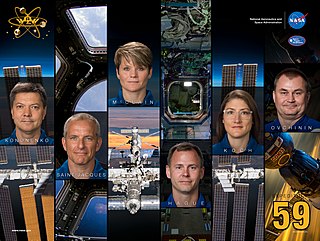
Expedition 59 was the 59th Expedition to the International Space Station. It started with the arrival of the Soyuz MS-12 spacecraft carrying Aleksey Ovchinin, Nick Hague and Christina Koch, joining Oleg Kononenko, David Saint-Jacques and Anne McClain who transferred from Expedition 58. The expedition formally began on March 15, 2019. Ovchinin and Hague were originally meant to fly to the ISS aboard Soyuz MS-10, but returned to Earth minutes after takeoff due to a contingency abort. The expedition formally ended with the undocking of the Soyuz MS-11 spacecraft carrying Kononenko, Saint-Jacques and McClain on 24 June 2019; Ovchinin, Hague and Koch transferred to Expedition 60.
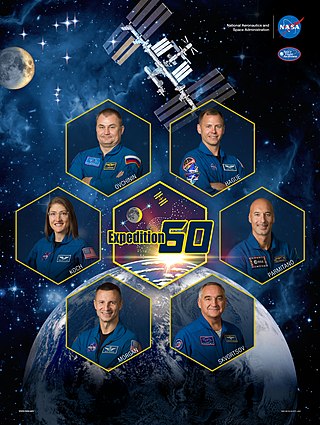
Expedition 60 was the 60th Expedition to the International Space Station, which began on 24 June 2019 with the undocking of the Soyuz MS-11 spacecraft. The expedition was commanded by Aleksey Ovchinin, who transferred from Expedition 59 together with American flight engineers Nick Hague and Christina Koch. They were joined by Aleksandr Skvortsov, Luca Parmitano and Andrew Morgan, who arrived on Soyuz MS-13 on 20 July 2019. The expedition ended on 3 October 2019, when Soyuz MS-12 undocked from the station and Koch, Skvortsov, Parmitano and Morgan transferred to Expedition 61.

Soyuz MS-14 was a Soyuz spaceflight to the International Space Station. It carried no crew members, as it was intended to test a modification of the launch abort system for integration with the Soyuz-2.1a launch vehicle. It launched successfully on 22 August 2019 at 03:38 UTC. It was the first mission of the Soyuz crew vehicle without a crew in 33 years, and the first ever unpiloted mission of Soyuz to the ISS.
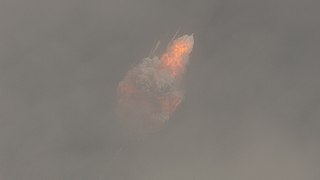
SpaceXCrew Dragon In-Flight Abort Test was a successful test of the SpaceX Dragon 2 abort system, conducted on 19 January 2020. It was the final assessment for the Crew Dragon capsule and Falcon 9 launch system before they would be certified to carry humans into space. Booster B1046.4 and an uncrewed capsule C205 were launched from Launch Complex 39A (LC-39A) on a suborbital trajectory, followed by an in-flight abort of the capsule at max Q and supersonic speed. The test was carried out successfully: the capsule pulled itself away from the booster after launch control commanded the abort, and landed safely.
